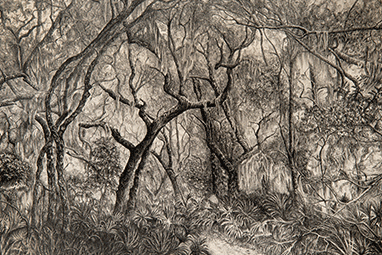SPARTANBURG, S.C. – When he was young, Spartanburg artist Jim Creal often went to the South Carolina coast with his family, enjoying the vivid light greens of the spartina grass and the palm fronds, the sea breezes and the bright sunlight that played in and out of the clouds.
“I saw the beauty of the environment as a child every year,” says Creal, a Spartanburg native. “As a young adult, we visited Kiawah, which was being beautifully developed with manty areas left in a natural, undeveloped state. Now, it’s virtually all developed – but still beautiful.”
It was then that he began his love affair with the coast – its mood, its spirit and the rich diversity of the creatures that inhabited it.
That love affair led Creal to create – over the past 25-plus years – a collection of lithographs for The South Carolina Coastal Lithographic Project. An exhibition of 20 of the lithographs, now are on exhibit on the upper level of the Richardson Family Art Museum in the Rosalind Sallenger Richardson Center for the Arts at Wofford College. The exhibition runs through Saturday, Aug. 4.
The original mission of The South Carolina Coastal Lithograph Project, pieces of which are on display through early August at Wofford, was “to create a lasting body of lithographic work devoted to capturing the mood, spirit and rich diversity of South Carolina’s coastal habitats and some of their extraordinary indigenous creates,” Creal says. In the exhibit, the artist has augmented the original project to include not only the hand-produced original lithographs but also has added his documentary site and habitat photographs to flush out telling his story of the coast’s ecosystem.
“This project is my way of sharing with audiences the visual story and magnificent beauty of South Carolina’s coastal habitats, their combined significance as a vital ecosystem under stress and their value as a national treasure that needs to be preserved for future generations,” says Creal. The program and the exhibit are free and open to the public. Hours for exhibit are Tuesday-Saturday, 1 to 5 p.m., with extended hours to 9 p.m. on Thursday; the exhibit will be part of the Spartanburg ArtWalk on the third Thursday of each month from 5 to 9 p.m.
“South Carolina is home to one of the longest stretches of barriers islands in the United States, and the habitats encompassing these islands form an ecosystem of awe-inspiring beauty and ecological importance,” Creal says, adding that there has been a significant loss of wild habitat along the state’s coast during his lifetime. “There will be a continuous struggle between the forces of preservation and development for the remaining undeveloped coastal areas. If predictions of rising sea levels come true, these coastal habitats will change dramatically in the relatively near future. What is here today may not be there for future generations to enjoy.”
For the project, Creal explored numerous coastal sites, including locations along the Grand Strand, the Santee Peedee Delta Region and Cape Romain Area, the Barrier Islands from Bulls Island to Edisto, and the Lowcountry from the Ace Basin to Savannah, Ga.
Creal chose to combine his regard and concern for the viability of South Carolina’s coastal habitats with his love of stone lithography, capturing its natural habitats: shores, dunes, climax maritime forests, barrier islands, salt and brackish water marshes, mud flats, bordering rivers and inlets.
“I love drawing on a grained lithographic stone. It is a meditative act from which incredibly rich drawing tonalities and textures are possible,” Creal says. He has studied and worked in lithography since the mid-1990s when he received a grant from the Spartanburg Arts Council – the predecessor of the Chapman Cultural Center – to study with an expert in the field at the University of South Carolina, Boyd Sanders.
Another grant, one from the South Carolina Arts Commission’s Artist Venture Initiative program, allowed him to set up to produce lithographs in his Spartanburg studio and to study under artist and lithographer Lynn Froelich of Charlotte, N.C. “Lithography is a very twitchy print process, and many of these lithographs would not exist but for the collaborative help of Lynn to print them,” he says.
Lithographs are “stone prints” created using a large limestone slab on which to draw the desired image with “greasy tools” such as lithographic crayons and utilizes the fact that oil and water do not mix. The processing and printing of the image involves many steps and may opportunities for thigns to go awry, Creal says.
The exhibition at Wofford is “the first time ever that I’ve gotten my whole body of lithographic work in one space,” Creal says, adding that he has included in the exhibit some pieces that “didn’t work out” as a “lesson.” “You can embark on something with great hope that everything will turn out perfect, but it doesn’t always.”
He just hopes those who see his works showcasing South Carolina’s rich coastal area go away with the idea that “we, as South Carolinians, should be proud of the beauty of these habitats and we should want to preserve them.”
South Carolina Coastal Lithograph Project showcases spirit, beauty, diversity
Spartanburg artist Jim Creal exhibits at Wofford College
Lithograph by Jim Creal of Prichards Island on the South Carolina coast
2018-06-21